Construction of an Ecological Security Pattern in Yangtze River Delta Based on Circuit Theory
Abstract
1. Introduction
2. Materials and Methods
2.1. Study Area
2.2. Data Source
2.3. Identification of Ecological Security Pattern
2.3.1. Ecological Source Identification
- Water conservation
- 2.
- Soil and water conservation
- 3.
- Carbon sequestration service
- 4.
- Biodiversity
- 5.
- Morphological Spatial Pattern Analysis
- 6.
- Landscape connectivity
2.3.2. Ecological Resistance Surfaces and Ecological Corridors
- Construction of ecological resistance surface
- 2.
- Construction of ecological corridors
2.3.3. Identification of Key Areas for Ecological Restoration of Land Space
3. Results
3.1. Spatial Distribution of Ecosystem Services in the YRD
3.2. Spatial Distribution of Ecological Sources
3.3. Resistance Surface and Ecological Corridor Construction
3.4. Key Areas for Ecological Restoration of Land Space
4. Discussion
5. Conclusions
Author Contributions
Funding
Institutional Review Board Statement
Informed Consent Statement
Data Availability Statement
Acknowledgments
Conflicts of Interest
References
- Fang, X.; Ma, Q.; Wu, L.; Liu, X. Distributional environmental justice of residential walking space: The lens of urban ecosystem services supply and demand. J. Environ. Manag. 2023, 329, 117050. [Google Scholar]
- Peng, J.; Zhao, H.; Liu, Y.; Wu, J. Research progress and prospect on regional ecological security pattern construction. Geogr. Res 2017, 36, 407–419. [Google Scholar]
- Fang, X.; Wu, J.; He, C. Assessing human-environment system sustainability based on Regional Safe and Just Operating Space: The case of the Inner Mongolia Grassland. Environ. Sci. Policy 2021, 116, 276–286. [Google Scholar]
- Martin, D.M. Ecological restoration should be redefined for the twenty-first century. Restor. Ecol. 2017, 25, 668–673. [Google Scholar] [CrossRef] [PubMed]
- Wang, C.; Liu, Y.; Yu, C.; Liu, X. Research progress on the arrangement of territorial ecological restoration. Prog. Geogr. 2021, 40, 1925–1941. [Google Scholar] [CrossRef]
- Wortley, L.; Hero, J.M.; Howes, M. Evaluating ecological restoration success: A review of the literature. Restor. Ecol. 2013, 21, 537–543. [Google Scholar] [CrossRef]
- Zastrow, M. China’s tree-planting could falter in a warming world. Nature 2019, 573, 474–475. [Google Scholar] [CrossRef]
- Yu, K. Security patterns and surface model in landscape ecological planning. Landsc. Urban Plan. 1996, 36, 1–17. [Google Scholar] [CrossRef]
- McRae, B.H.; Dickson, B.G.; Keitt, T.H.; Shah, V.B. Using Circuit Theory to Model Connectivity in Ecology, Evolution, and Conservation. Ecology 2008, 89, 2712–2724. [Google Scholar] [CrossRef]
- Lu, Z.G.; Li, W.; Wang, Y.D.; Zhou, S.Y. Bibliometric Analysis of Global Research on Ecological Networks in Nature Conservation from 1990 to 2020. Sustainability 2022, 14, 4925. [Google Scholar] [CrossRef]
- The President’s Council on Sustainable Development. Towards a Sustainable America: Advancing Prosperity, Opportunity, and a Healthy Environment for the 21st Century; Diane Publishing: Darby, PA, USA, 1999.
- Hilty, J.; Worboys, G.L.; Keeley, A.; Woodley, S.; Lausche, B.; Locke, H.; Carr, M.; Pulsford, I.; Pittock, J.; White, J.W. Guidelines for conserving connectivity through ecological networks and corridors. In Best Practice Protected Area Guidelines Series; IUCN: Gland, Switzerland, 2020; Volume 30, p. 122. [Google Scholar]
- Hofman, M.P.G.; Hayward, M.W.; Kelly, M.J.; Balkenhol, N. Enhancing conservation network design with graph-theory and a measure of protected area effectiveness: Refining wildlife corridors in Belize, Central America. Landsc. Urban Plan. 2018, 178, 51–59. [Google Scholar]
- Duan, J.; Fang, X.; Long, C.; Liang, Y.; Cao, Y.E.; Liu, Y.; Zhou, C. Identification of Key Areas for Ecosystem Restoration Based on Ecological Security Pattern. Sustainability 2022, 14, 15499. [Google Scholar] [CrossRef]
- Ramyar, R.; Ackerman, A.; Johnston, D.M. Adapting cities for climate change through urban green infrastructure planning. Cities 2021, 117, 103316. [Google Scholar] [CrossRef]
- Pearce, H.; Levine, J.G.; Cai, X.; MacKenzie, A.R. Introducing the Green Infrastructure for Roadside Air Quality (GI4RAQ) Platform: Estimating Site-Specific Changes in the Dispersion of Vehicular Pollution Close to Source. Forests 2021, 12, 769. [Google Scholar] [CrossRef]
- Zhang, J.B.; Zhu, H.R.; Zhang, P.Y.; Song, Y.P.; Zhang, Y.; Li, Y.Y.; Rong, T.Q.; Liu, Z.Y.; Yang, D.; Lou, Y.Y. Construction of GI Network Based on MSPA and PLUS Model in the Main Urban Area of Zhengzhou: A Case Study. Front. Environ. Sci. 2022, 10, 878656. [Google Scholar]
- Zhang, J.; Feng, X.; Shi, W.; Cui, J.; Peng, J.; Lei, L.; Zhang, J.; Astell-Burt, T.; Jiang, Y.; Ma, J. Health promoting green infrastructure associated with green space visitation. Urban For. Urban Green. 2021, 64, 127237. [Google Scholar] [CrossRef]
- Peng, J.; Yang, Y.; Liu, Y.; Hu, Y.N.; Du, Y.; Meersmans, J.; Qiu, S. Linking ecosystem services and circuit theory to identify ecological security patterns. Sci. Total Environ. 2018, 644, 781–790. [Google Scholar] [CrossRef] [PubMed]
- Guo, H.; Yu, Q.; Pei, Y.; Wang, G.; Yue, D. Optimization of landscape spatial structure aiming at achieving carbon neutrality in desert and mining areas. J. Clean. Prod. 2021, 322, 129156. [Google Scholar] [CrossRef]
- Wu, J.; Zhang, L.; Peng, J.; Feng, Z.; Liu, H.; He, S. The integrated recognition of the source area of the urban ecological security pattern in Shenzhen. Acta Ecol. Sin 2013, 33, 4125–4133. [Google Scholar]
- Yang, Y.; Chen, J.; Huang, R.; Feng, Z.; Zhou, G.; You, H.; Han, X. Construction of Ecological Security Pattern Based on the Importance of Ecological Protection-A Case Study of Guangxi, a Karst Region in China. Int. J. Environ. Res. Public Health 2022, 19, 108962. [Google Scholar]
- Zuo, Q.; Zhou, Y.; Wang, L.; Li, Q.; Liu, J.Y. Impacts of future land use changes on land use conflicts based on multiple scenarios in the central mountain region, China. Ecol. Indic. 2022, 137, 108743. [Google Scholar] [CrossRef]
- Gou, M.M.; Li, L.; Ouyang, S.; Shu, C.; Xiao, W.F.; Wang, N.; Hu, J.W.; Liu, C.F. Integrating ecosystem service trade-offs and rocky desertification into ecological security pattern construction in the Daning river basin of southwest China. Ecol. Indic. 2022, 138, 108845. [Google Scholar] [CrossRef]
- Tao, Q.; Gao, G.; Xi, H.; Wang, F.; Cheng, X.; Ou, W.; Tao, Y. An integrated evaluation framework for multiscale ecological protection and restoration based on multi-scenario trade-offs of ecosystem services: Case study of Nanjing City, China. Ecol. Indic. 2022, 140, 108962. [Google Scholar] [CrossRef]
- Zhang, Y.L.; Zhao, Z.Y.; Yang, Y.Y.; Fu, B.J.; Ma, R.M.; Lue, Y.H.; Wu, X. Identifying ecological security patterns based on the supply, demand and sensitivity of ecosystem service: A case study in the Yellow River Basin, China. J. Environ. Manag. 2022, 315, 115158. [Google Scholar] [CrossRef]
- Jiang, H.; Peng, J.; Dong, J.; Zhang, Z.; Xu, Z.; Meersmans, J. Linking ecological background and demand to identify ecological security patterns across the Guangdong-Hong Kong-Macao Greater Bay Area in China. Landsc. Ecol. 2021, 36, 2135–2150. [Google Scholar] [CrossRef]
- Dai, L.; Liu, Y.; Luo, X. Integrating the MCR and DOI models to construct an ecological security network for the urban agglomeration around Poyang Lake, China. Sci. Total Environ. 2021, 754, 141868. [Google Scholar] [CrossRef]
- Su, J.; Yin, H.; Kong, F. Ecological networks in response to climate change and the human footprint in the Yangtze River Delta urban agglomeration, China. Landsc. Ecol. 2021, 36, 2095–2112. [Google Scholar] [CrossRef]
- Hilty, J.A.; Keeley, A.T.; Merenlender, A.M.; Lidicker, W.Z., Jr. Corridor Ecology: Linking Landscapes for Biodiversity Conservation and Climate Adaptation; Island Press: Washington, DC, USA, 2019. [Google Scholar]
- Chen, Y.; Wang, J.L.; Kurbanov, E.; Thomas, A.; Sha, J.M.; Jiao, Y.M.; Zhou, J.C. Ecological security assessment at different spatial scales in central Yunnan Province, China. PLoS ONE 2022, 17, e0270267. [Google Scholar] [CrossRef]
- Peng, J.; Zhao, S.; Dong, J.; Liu, Y.; Meersmans, J.; Li, H.; Wu, J. Applying ant colony algorithm to identify ecological security patterns in megacities. Environ. Model. Softw. 2019, 117, 214–222. [Google Scholar] [CrossRef]
- Zhao, S.-M.; Ma, Y.-F.; Wang, J.-L.; You, X.-Y. Landscape pattern analysis and ecological network planning of Tianjin City. Urban For. Urban Green. 2019, 46, 126479. [Google Scholar] [CrossRef]
- Dong, J.; Peng, J.; Liu, Y.; Qiu, S.; Han, Y. Integrating spatial continuous wavelet transform and kernel density estimation to identify ecological corridors in megacities. Landsc. Urban Plan. 2020, 199, 103815. [Google Scholar] [CrossRef]
- Gao, J.; Du, F.; Zuo, L.; Jiang, Y. Integrating ecosystem services and rocky desertification into identification of karst ecological security pattern. Landsc. Ecol. 2021, 36, 2113–2133. [Google Scholar] [CrossRef]
- Wu, Y.; Han, Z.; Meng, J.; Zhu, L. Circuit theory-based ecological security pattern could promote ecological protection in the Heihe River Basin of China. Environ. Sci. Pollut. Res. 2022, 30, 27340–27356. [Google Scholar] [CrossRef] [PubMed]
- CBD. Zero draft of the post-2020 global biodiversity framework. In Proceedings of the Convention on Biological Diversity, Montreal, QC, Canada, 24–29 August 2020. [Google Scholar]
- Xu, H.; Cao, Y.; Yu, D.; Cao, M.; He, Y.; Gill, M.; Pereira, H.M. Ensuring effective implementation of the post-2020 global biodiversity targets. Nat. Ecol. Evol. 2021, 5, 411–418. [Google Scholar] [CrossRef] [PubMed]
- Gnacadja, L.; Vidal, A. How can science help to implement the UN Decade on Ecosystem Restoration 2021–2030? Philos. Trans. R. Soc. B Biol. Sci. 2023, 378, 1867. [Google Scholar] [CrossRef] [PubMed]
- UN. United Nations Decade on Ecosystem Restoration (2021–2030); United Nations: New York, NY, USA, 2019. [Google Scholar]
- Fang, X.; Zhou, B.; Tu, X.; Ma, Q.; Wu, J. “What kind of a science is sustainability science?” An evidence-based reexamination. Sustainability 2018, 10, 1478. [Google Scholar] [CrossRef]
- Cai, W.B.; Wu, T.; Jiang, W.; Peng, W.T.; Cai, Y.L. Integrating Ecosystem Services Supply-Demand and Spatial Relationships for Intercity Cooperation: A Case Study of the Yangtze River Delta. Sustainability 2020, 12, 4131. [Google Scholar] [CrossRef]
- Gao, J.; Wang, L.C. Embedding spatiotemporal changes in carbon storage into urban agglomeration ecosystem management—A case study of the Yangtze River Delta, China. J. Clean. Prod. 2019, 237, 117764. [Google Scholar] [CrossRef]
- Kang, J.M.; Li, C.L.; Zhang, B.L.; Zhang, J.; Li, M.R.; Hu, Y.M. How do natural and human factors influence ecosystem services changing? A case study in two most developed regions of China. Ecol. Indic. 2023, 146, 109891. [Google Scholar] [CrossRef]
- Zhang, C.; Xie, G.; Liu, C.; Fan, N.; Wang, X. Evaluation of water conservation of China’s ecosystems based on benchmark. Acta Ecol. Sin 2022, 22, 1–11. [Google Scholar]
- Zhou, J.; Gao, J.; Gao, Z.; Yang, W. Analyzing the water conservation service function of the forest ecosystem. Acta Ecol. Sin. 2018, 38, 1679–1686. [Google Scholar]
- Zhang, D.; Qu, L.; Zhang, J. Ecological security pattern construction method based on the perspective of ecological supply and demand: A case study of Yangtze River Delta. Acta Ecol. Sin 2019, 39, 7525–7537. [Google Scholar]
- Teng, H.F.; Liang, Z.Z.; Chen, S.C.; Liu, Y.; Rossel, R.A.V.; Chappell, A.; Yu, W.; Shi, Z. Current and future assessments of soil erosion by water on the Tibetan Plateau based on RUSLE and CMIP5 climate models. Sci. Total Environ. 2018, 635, 673–686. [Google Scholar] [CrossRef] [PubMed]
- Peng, J.; Pan, Y.J.; Liu, Y.X.; Zhao, H.J.; Wang, Y.L. Linking ecological degradation risk to identify ecological security patterns in a rapidly urbanizing landscape. Habitat Int. 2018, 71, 110–124. [Google Scholar] [CrossRef]
- Wei, L.; Zhou, L.; Sun, D.Q.; Yuan, B.; Hu, F.N. Evaluating the impact of urban expansion on the habitat quality and constructing ecological security patterns: A case study of Jiziwan in the Yellow River Basin, China. Ecol. Indic. 2022, 145, 109544. [Google Scholar] [CrossRef]
- Huang, M.; Yue, W.; Feng, S.; Zhang, J. Spatial-temporal evolution of habitat quality and analysis of landscape patterns in Dabie Mountain area of west Anhui province based on InVEST model. Acta Ecol. Sin 2020, 40, 2895–2906. [Google Scholar]
- Sharp, R.; Tallis, H.; Ricketts, T.; Guerry, A.; Wood, S.; Chaplin-Kramer, R.; Nelson, E.; Ennaanay, D.; Wolny, S.; Olwero, N. InVEST 3.2. 0 User’s Guide. In The Natural Capital Project; Stanford University: Stanford, CA, USA, 2018. [Google Scholar]
- Vogt, P.; Riitters, K. GuidosToolbox: Universal digital image object analysis. Eur. J. Remote Sens. 2017, 50, 352–361. [Google Scholar] [CrossRef]
- Vogt, P.; Riitters, K.H.; Iwanowski, M.; Estreguil, C.; Kozak, J.; Soille, P. Mapping landscape corridors. Ecol. Indic. 2007, 7, 481–488. [Google Scholar] [CrossRef]
- Vogt, P.; Ferrari, J.R.; Lookingbill, T.R.; Gardner, R.H.; Riitters, K.H.; Ostapowicz, K. Mapping functional connectivity. Ecol. Indic. 2009, 9, 64–71. [Google Scholar] [CrossRef]
- Martinez Pardo, J.; Saura, S.; Insaurralde, A.; Di Bitetti, M.S.; Paviolo, A.; De Angelo, C. Much more than forest loss: Four decades of habitat connectivity decline for Atlantic Forest jaguars. Landsc. Ecol. 2022, 38, 41–57. [Google Scholar] [CrossRef]
- Chen, X.; Peng, J.; Liu, Y.; Yang, Y.; Li, G. Constructing ecological security patterns in Yunfu city based on the framework of importance-sensitivity-connectivity. Geogr. Res 2017, 36, 471–484. [Google Scholar]
- Saura, S.; Pascual-Hortal, L. A new habitat availability index to integrate connectivity in landscape conservation planning: Comparison with existing indices and application to a case study. Landsc. Urban Plan. 2007, 83, 91–103. [Google Scholar]
- Fang, X.; Wu, J. Causes of overgrazing in Inner Mongolian grasslands: Searching for deep leverage points of intervention. Ecol. Soc. 2022, 27, 8. [Google Scholar] [CrossRef]
- An, Y.; Liu, S.L.; Sun, Y.X.; Shi, F.N.; Beazley, R. Construction and optimization of an ecological network based on morphological spatial pattern analysis and circuit theory. Landsc. Ecol. 2021, 36, 2059–2076. [Google Scholar] [CrossRef]
- McRae, B.H.; Hall, S.A.; Beier, P.; Theobald, D.M. Where to Restore Ecological Connectivity? Detecting Barriers and Quantifying Restoration Benefits. PLoS ONE 2012, 7, e52604. [Google Scholar] [CrossRef] [PubMed]
- Leonard, P.B.; Duffy, E.B.; Baldwin, R.F.; McRae, B.H.; Shah, V.B.; Mohapatra, T.K. gflow: Software for modelling circuit theory-based connectivity at any scale. Methods Ecol. Evol. 2017, 8, 519–526. [Google Scholar] [CrossRef]
- Dong, J.; Peng, J.; Xu, Z.; Liu, Y.; Wang, X.; Li, B. Integrating regional and interregional approaches to identify ecological security patterns. Landsc. Ecol. 2021, 36, 2151–2164. [Google Scholar] [CrossRef]
- Wang, Y.Z.; Gu, X.C.; Yu, H.R. Spatiotemporal Variation in the Yangtze River Delta Urban Agglomeration from 1980 to 2020 and Future Trends in Ecosystem Services. Land 2023, 12, 929. [Google Scholar] [CrossRef]
- Brennan, A.; Naidoo, R.; Greenstreet, L.; Mehrabi, Z.; Ramankutty, N.; Kremen, C. Functional connectivity of the world’s protected areas. Science 2022, 376, 1101–1104. [Google Scholar] [CrossRef]
- Gao, M.W.; Hu, Y.C.; Bai, Y.P. Construction of ecological security pattern in national land space from the perspective of the community of life in mountain, water, forest, field, lake and grass: A case study in Guangxi Hechi, China. Ecol. Indic. 2022, 139, 108867. [Google Scholar]
- Fang, X.; Li, J.; Ma, Q. Integrating green infrastructure, ecosystem services and nature-based solutions for urban sustainability: A comprehensive literature review. Sustain. Cities Soc. 2023, 98, 104843. [Google Scholar] [CrossRef]
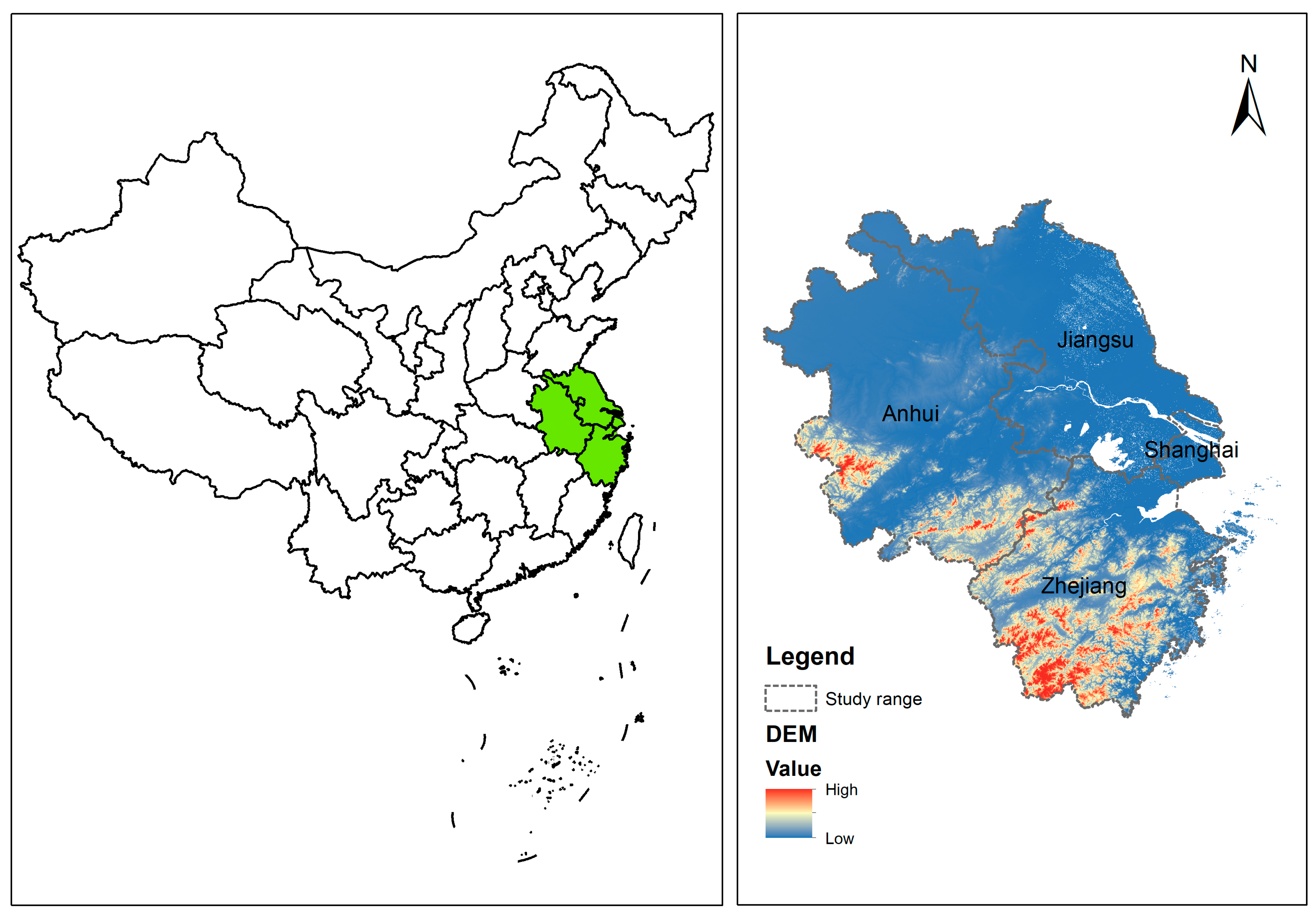
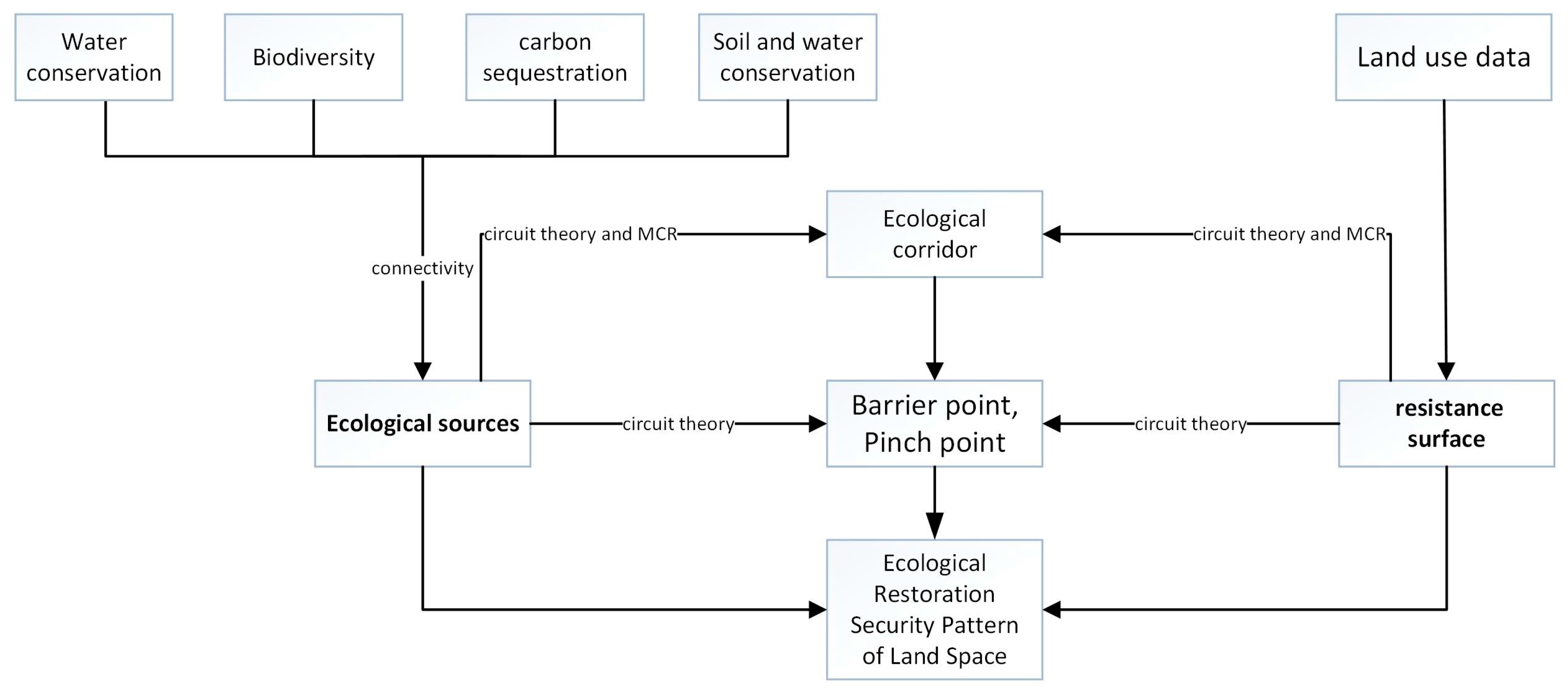
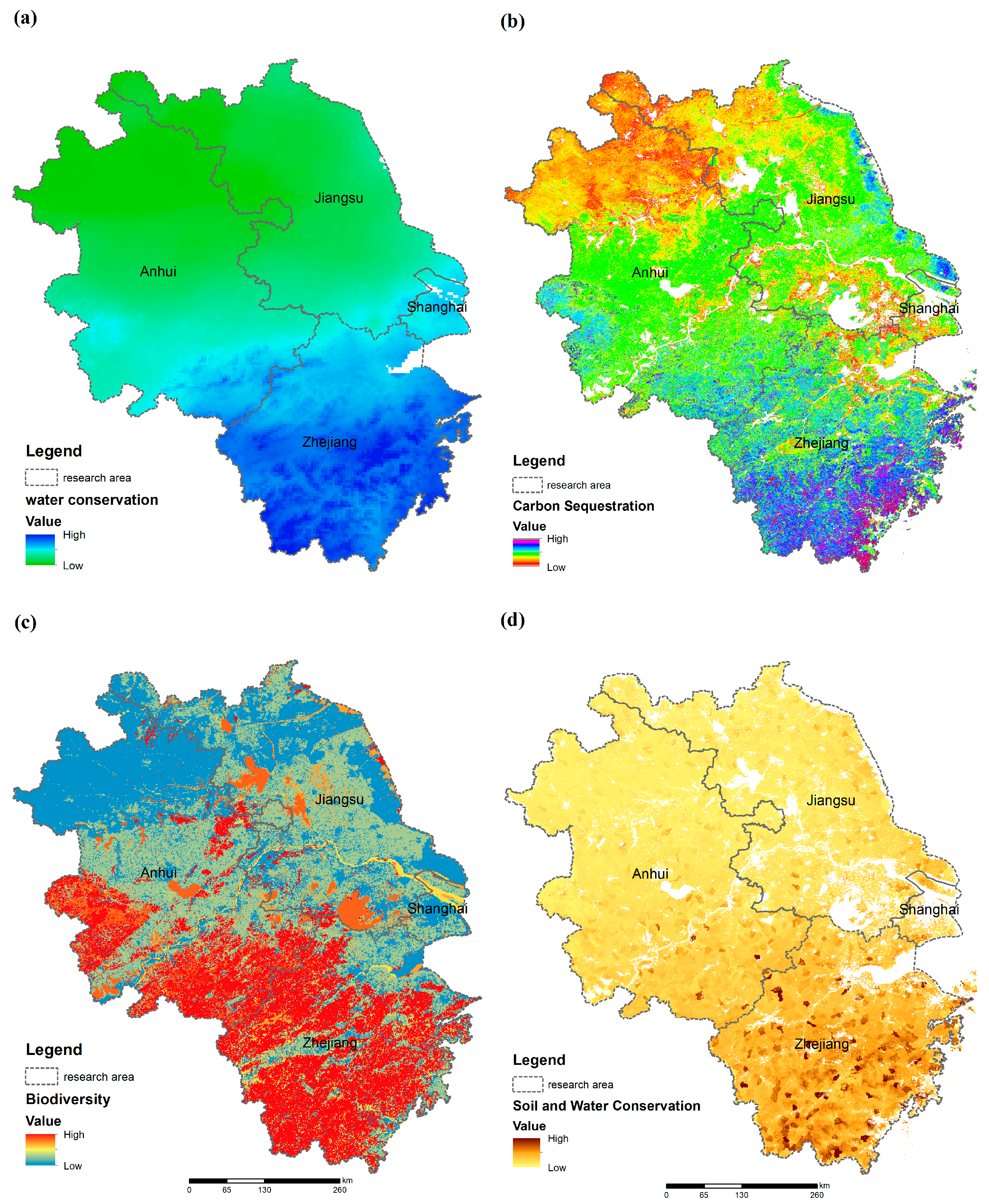

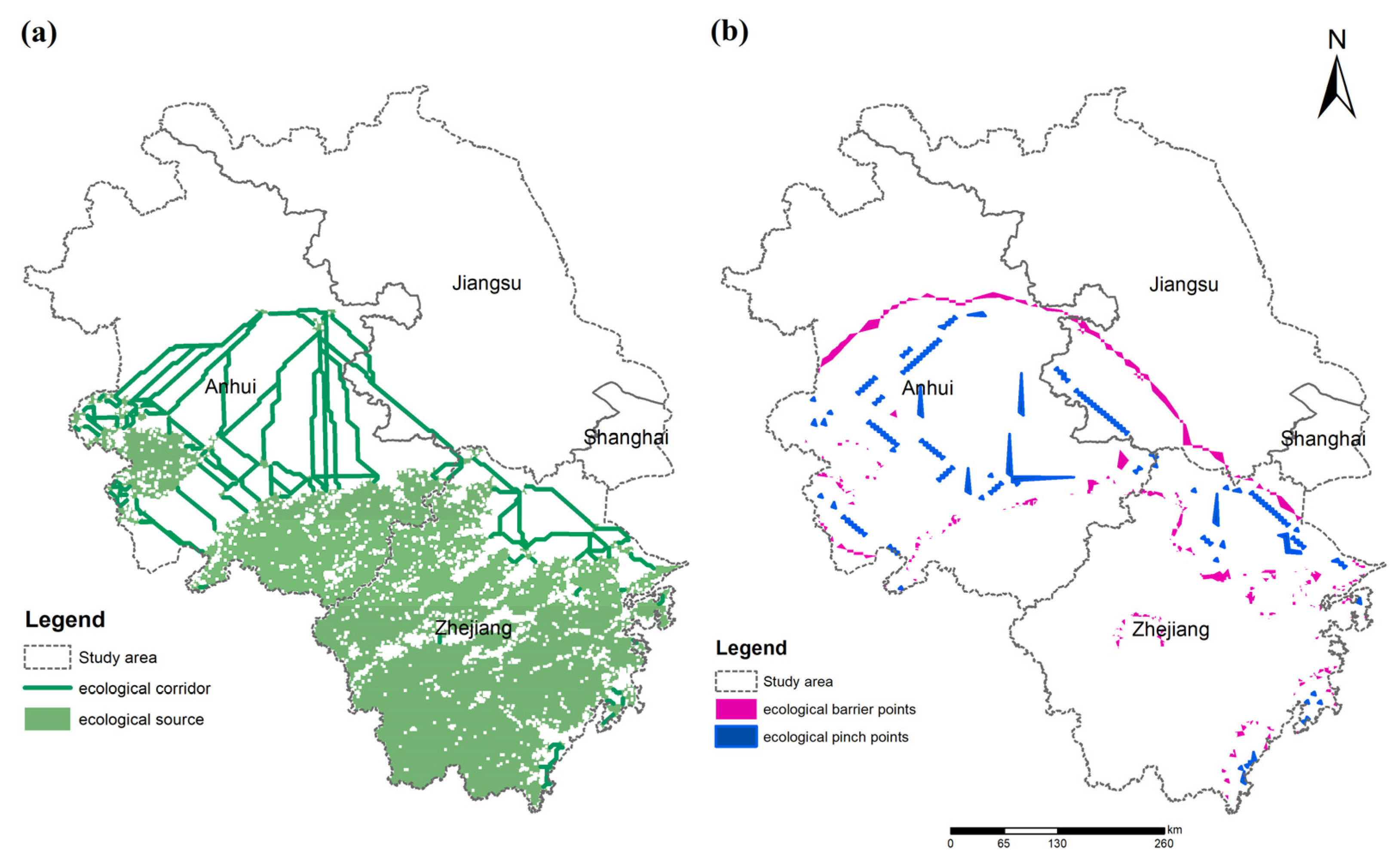
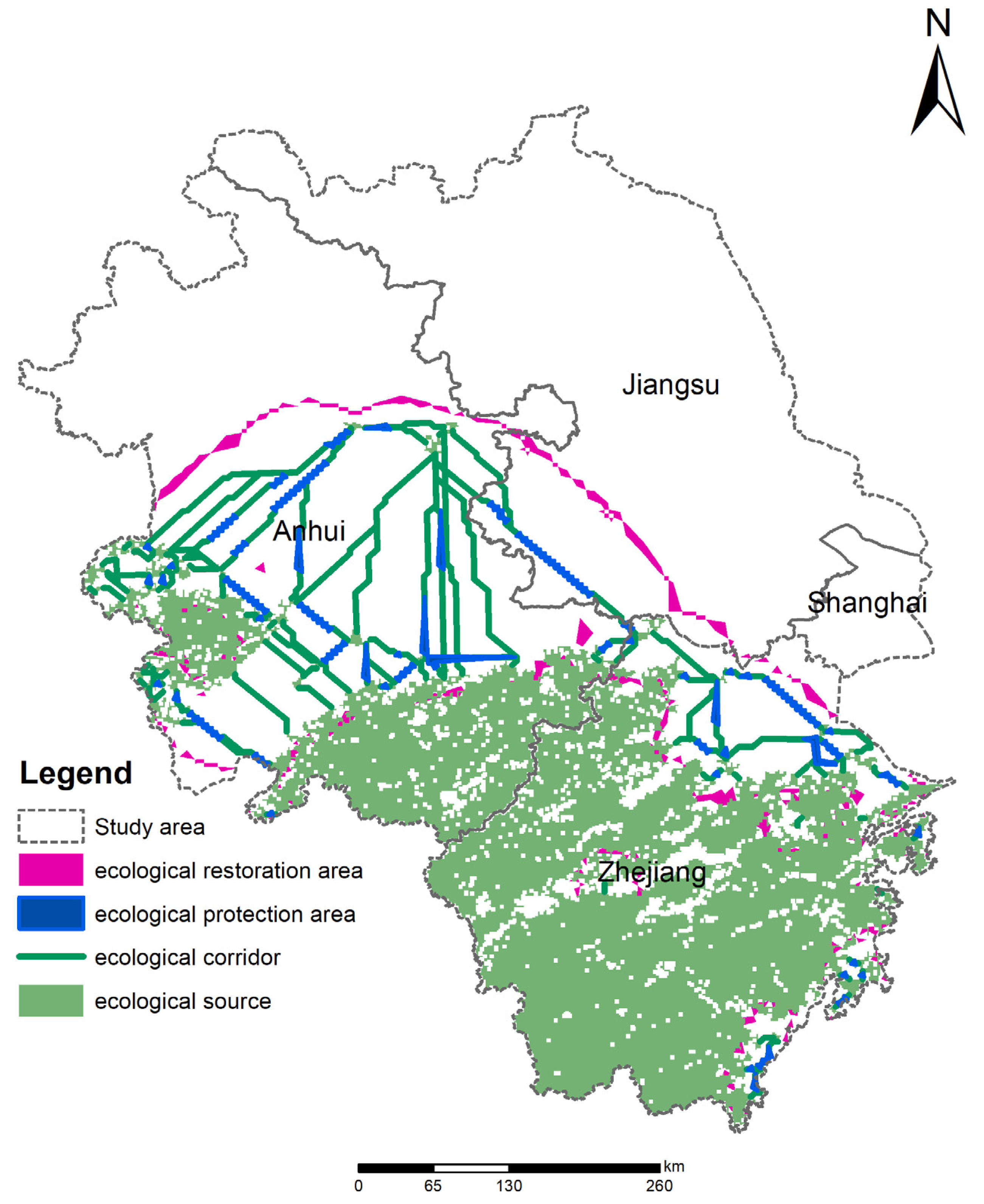
| Threat Sources | Maximum Duress Distance/km | Weights | Type of Spatial Recession |
|---|---|---|---|
| Paddy field | 4 | 0.5 | exponential |
| dry land | 1 | 0.15 | linear |
| urban land | 3 | 0.6 | linear |
| rural settlements | 5 | 1 | exponential |
| Other construction land | 2 | 0.4 | linear |
| Land Use/Cover Type | Habitat Suitability | Paddy Field | Dry Land | Urban Land | Rural Residential Area | Other Construction Land |
|---|---|---|---|---|---|---|
| Paddy field | 0.4 | 0 | 0.1 | 0.5 | 0.3 | 0.2 |
| Dry land | 0.2 | 0.2 | 0 | 0.5 | 0.2 | 0.2 |
| Wooded land | 1 | 0.8 | 0.8 | 1 | 0.8 | 0.6 |
| Shrubs | 0.8 | 0.4 | 0.4 | 0.6 | 0.4 | 0.2 |
| woodland | 0.6 | 0.8 | 0.8 | 1 | 0.8 | 0.5 |
| Other woodlands | 0.6 | 0.6 | 0.6 | 0.9 | 0.8 | 0.5 |
| High cover grassland | 0.9 | 0.7 | 0.7 | 0.9 | 0.8 | 0.6 |
| Medium covered grassland | 0.7 | 0.4 | 0.4 | 0.6 | 0.5 | 0.3 |
| Low cover grassland | 0.5 | 0.3 | 0.3 | 0.6 | 0.4 | 0.4 |
| River | 0.6 | 0.7 | 0.6 | 0.8 | 0.6 | 0.4 |
| Lake | 0.8 | 0.7 | 0.6 | 0.8 | 0.7 | 0.5 |
| Reservoir Pond | 0.7 | 0.8 | 0.7 | 0.7 | 0.7 | 0.4 |
| Beach | 0.7 | 0.6 | 0.6 | 0.8 | 0.7 | 0.5 |
| Urban land | 0 | 0 | 0 | 0 | 0 | 0 |
| Rural residential area | 0 | 0 | 0 | 0 | 0 | 0 |
| Industrial and mining land | 0 | 0 | 0 | 0 | 0 | 0 |
| Sand | 0.1 | 0.2 | 0.6 | 0.8 | 0.7 | 0.6 |
| Gobi | 0.1 | 0.1 | 0.5 | 0.7 | 0.7 | 0.6 |
| Bare soil | 0.2 | 0.1 | 0.5 | 0.7 | 0.8 | 0.7 |
| Hare rock | 0.3 | 0.1 | 0.5 | 0.8 | 0.7 | 0.6 |
| Paddy field | 0.4 | 0 | 0.1 | 0.5 | 0.3 | 0.2 |
| Dry land | 0.2 | 0.2 | 0 | 0.5 | 0.2 | 0.2 |
| Landscape Type | Ecological Meaning |
|---|---|
| Core area | Larger habitat patches in foreground pixels can provide larger habitats for species, which is of great significance to the protection of biodiversity and is the ecological source of ecological networks. |
| Bridge | The narrow and long areas connecting the core area represent the corridors connecting the patches in the ecological network, which is of great significance for biological migration and landscape connection. |
| Edge | It is the transition area between the core area and the main non-green landscape area. |
| Branch | Corridors connecting the same core area are shortcuts for species migration in the same core area. |
| Ring | The transition area between the core area and the non-green landscape patch, that is, the inner patch edge. |
| Island | A region connected at only one end to an edge region, bridge region, ring region, or pore. |
| Perforation | Isolated and broken small plaques that are not connected to each other, the degree of connection between the plaques is relatively low, and the possibility of internal material and energy exchange and transmission is relatively small. |
Disclaimer/Publisher’s Note: The statements, opinions and data contained in all publications are solely those of the individual author(s) and contributor(s) and not of MDPI and/or the editor(s). MDPI and/or the editor(s) disclaim responsibility for any injury to people or property resulting from any ideas, methods, instructions or products referred to in the content. |
© 2023 by the authors. Licensee MDPI, Basel, Switzerland. This article is an open access article distributed under the terms and conditions of the Creative Commons Attribution (CC BY) license (https://creativecommons.org/licenses/by/4.0/).
Share and Cite
Duan, J.; Cao, Y.‘e.; Liu, B.; Liang, Y.; Tu, J.; Wang, J.; Li, Y. Construction of an Ecological Security Pattern in Yangtze River Delta Based on Circuit Theory. Sustainability 2023, 15, 12374. https://doi.org/10.3390/su151612374
Duan J, Cao Y‘e, Liu B, Liang Y, Tu J, Wang J, Li Y. Construction of an Ecological Security Pattern in Yangtze River Delta Based on Circuit Theory. Sustainability. 2023; 15(16):12374. https://doi.org/10.3390/su151612374
Chicago/Turabian StyleDuan, Jiaquan, Yue ‘e Cao, Bo Liu, Yinyin Liang, Jinyu Tu, Jiahui Wang, and Yeyang Li. 2023. "Construction of an Ecological Security Pattern in Yangtze River Delta Based on Circuit Theory" Sustainability 15, no. 16: 12374. https://doi.org/10.3390/su151612374
APA StyleDuan, J., Cao, Y. ‘e., Liu, B., Liang, Y., Tu, J., Wang, J., & Li, Y. (2023). Construction of an Ecological Security Pattern in Yangtze River Delta Based on Circuit Theory. Sustainability, 15(16), 12374. https://doi.org/10.3390/su151612374








